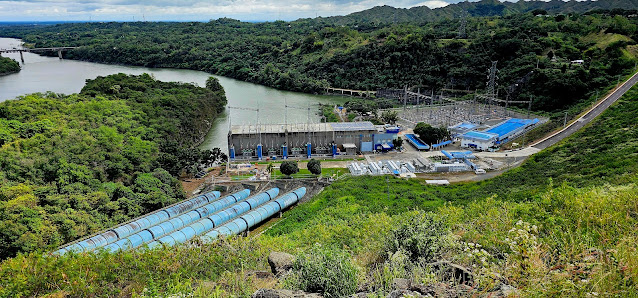Municipality of Peñablanca, Cagayan North
December 30, 2023
It was the 30th of December and we have decided to spend the day with a relaxing and fun family trip to the North of Isabela in the province of Cagayan.
 |
| Callao Cave |
The province is widely known by tourist as the home Province of the famous Pancit Batil Patong [made out of pansit miki Tuguegarao, minced carabao meat (water buffalo), bean sprouts and other vegetables topped with egg and chicharon. Batil Patong if directly translated means “beat the egg” for Batil and “placed on top” for Patong and that explains the egg on top] and the Callao Cave in the Municipality of Peñablanca within the Protected Landscape and Seascape.
Onboard our L300 van, we travelled North around 160km from home and almost a 4H drive. We had fun along the way passing by the Municipalities of Alicia, Cauayan, Naguilian, Ilagan, Tumauini, Cabagan, San Pablo, Tuguegarao and finally Peñablanca. The Cave is accessible from the main highway.
 |
| Protected Landscape and Seascape Tourist Information Office |
 |
| Picnic Area |
We registered at the entrance and met our Cave local guide - Arlem. It is a requirement of Cagayan Tourism office to secure a Cave guide at the entrance gate.
 |
| Tourist Registration Office |
To reach the entrance of the Cave, we need to climb a 184-step concrete stairs from the entrance gate. There is a comfort room near the entrance leading to the stairs.
 |
| Callao Cave Entrance |
Opposite the entrance of the Cave is a nice lush green landscape overlooking the Pinacanauan river and the foot of the mighty Sierra Madre mountain range - the longest mountain range in the Philippines.
 |
| Pinacanauan River and Sierra Madre Mountain Range |
After climbing up the concrete stairs, we reached the entrance of the Cave and marveled at the rock formations, stalactites and stalagmites inside.
 |
| Cave First Chamber - Near the Cave Entrance |
A sight that immediately captured my attention was the Cathedral-like ceiling of the second chamber where a chapel was built by the locals. The rock formations lighted by stream of sunlight from the ceiling served as the altar.
 |
| Cave Second Chamber - Cathedral-like Ceiling |
Arlem, our local guide, patiently guided us through the Chambers of the Cave. According to him, there are seven chambers of the Cave.
 |
| Cave Third Chamber |
 |
| Cave Fourth Chamber |
 |
| Cave Fifth Chamber |
Only the first until the fifth Chambers are accessible at that time. Arlem said, Chambers six and seven are under water due to the recent rains. Authorities said that there used to be nine Chambers but the 1980 earthquake cut-off the path going to the eight and nineth Chambers.
According to Wikipedia, Callao Cave (IPA: [kaʎaʊ]) is one of 300 limestone caves located in the Barangays of Magdalo and Quibal in the municipality of Peñablanca, about 24 km (15 mi) northeast of Tuguegarao City, the capital of Cagayan province within the Peñablanca Protected Landscape and Seascape in the western foothills of the Northern Sierra Madre Mountains on Luzon island in the Philippines. The town Peñablanca's (Spanish: white rocks) name refers to the predominance of white limestone rock formations in the area. First excavated in 1980 by Maharlika Cuevas, the seven-chamber show cave is the best known natural tourist attraction of the Cagayan province and in February 2020 has officially been recognized as an important cultural property of the Philippines.
Fossils of archaic humans, that lived during the Late Pleistocene were first discovered in the cave and documented in 2007 by a team led by Armand Salvador Mijares from the University of the Philippines and eventually confirmed in 2019 as to belong to a previously unknown and now extinct human sub-species - Callao Man or Homo luzonensis.
More than 300 caves dot the protected area, 75 of which have been documented by the National Museum since 1977. The Callao Cave and the nearby, but more challenging, Sierra Cave are easily accessible by automobile.
The Callao Cave is the premier attraction in the Peñablanca Protected Landscape and Seascape. It is the most accessible of all the caves, its entrance is reached by climbing 184 concrete steps. The Callao Cave system is composed of seven chambers, each with natural crevices above that let streams of light to get into the cave, serving as illumination for the otherwise dark areas of the place. Previously, there were reported nine caves in the system, but an earthquake in the 1980s cut off the last two chambers.
The first chamber of the show cave is the largest room with a width of about 50 m (160 ft) and a height of 36 m (118 ft).The cathedral-like room has been turned into a chapel by the local people. A rock formation serves as the altar of the chapel lit by a stream of light coming from a rooftop opening. The conditions inside the caves have caused the formation of stalactites and stalagmites, more so in the deeper chambers. Several spectacular speleothems or formations are found inside the cave like flowstones, glittering dripstones, cave curtains, crystal helictites, columns, etc.
We concluded our Caving adventure with a pose at the Callao Cave entrance before leaving the place.
 |
| Our Cave Guide Arlem |
A taste of the famous Cagayan Pancit Batil Patong concluded our family road trip. We left Cagayan with a happy heart and fulfilled curiosity about the famous Cave and Pancit Batil Patong.
 |
| Cagayan's Famous Pancit Batil Patong |
-o0o-












